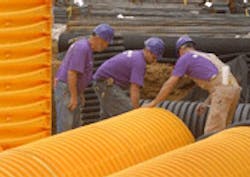Parking the Floodwater Underground
Imagine a program where you'd pay the local government a fee based on how much concrete you have on your property.
That's one of the options being considered by Mayor Jonathan Weinzapfel as a method to pay for $55 million in upcoming sewer projects, now being planned by city consultants.
Weinzapfel's administration is considering how it will pay for four drainage projects that are supposed to help alleviate flooding on the southeast side. The cost has been estimated at $55 million. The first project is scheduled to begin next year, with the last one scheduled for completion in 2012.
The mayor said the projects could be paid for with sewer rate increases, a "storm water management district" or a combination of both.
Sewer rate increases are not unusual. In fact, there was little remonstrance earlier this year, when a 6% bill hike was approved to help pay on the loans being used for numerous sewer-related projects, including the expansion of the West Side treatment plant.
The concept of a storm water management district, however, is a new concept to Evansville.
In such a district, property owners are charged a fee based on the amount of impervious surface they have on their property. Businesses with a large parking lot, for example, would pay more than those living in residential housing. And, in theory, a residence with a large patio could pay more than someone with a simple concrete stoop.
Since rainfall cannot penetrate parking lots, they generate large amounts of flowing water, worsening flooding, erosion and water pollution, said Bernard Engel, head of Purdue's Department of Agricultural and Biological Engineering. The pollutants that collect on these non-absorbent surfaces are easily carried away by rain, washed into waterways and sewers.
In the case of combined sewer systems such as Evansville's, this runoff adds to the volume of and the amount of pollution in the wastewater that can overflow into Pigeon Creek and the Ohio River, or back up into yards and homes, when Evansville's combined sewers get too full.
Source: Evansville Courier & Press; Evansville, IN
